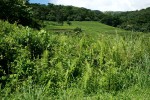Cyclosorus interruptus (Willd.) H. Itô
Synonyms |
Nephrodium unitum sensu Sim |
|---|---|
Common name |
|
Description |
Rhizome widely creeping, up to 6 mm in diameter; rhizome scales sparse, black, narrowly ovate, entire, up to 1.5 mm long. Fronds spaced up to 12 cm apart, erect, not proliferous, herbaceous, in full sun texture stiff, leathery. Stipe up to 93 cm long, pale brown, glabrous to minutely hairy, with a few black scales at the base. Lamina up to 0.8 m long, ovate-lanceolate in outline, 2-pinnatifid, lower pinnae largest or of equal size as those above, only rarely very slightly reduced in size. Pinnae very narrowly oblong, shortly petiolate to sessile, base truncate, incised a third of the way to halfway to the costa; veins 7-15 pairs per lobe, basal pair of veins anastomosing well below the sinus, next pair meeting at the sinus; under surface hairless or set with white hairs, particularly along the costae, costules and veins, with or without pale brown scales on the costae, also sometimes distinct red glands below, upper surface hairless. Rhachis pale brown, hairless to thinly covered with short hairs. Sori round, up to 18 per lobe, typically forming a zigzag pattern along each side of the costa; indusiate small, hairy, often shed early. |
Notes | Found together with Thelypteris confluens that has veins that are not anastomosing, small scales on costae below, herbaceous, pinnatifid pinnae.
|
Derivation | interruptus: interrupted, broken-up; unclear, referring to the spaced-out fronds on the rhizome or to describe the regularly incised pattern created by the pinnae lobes. |
Habitat | Marsh fern, depending on continuously wet soils or surface water, growing in grassland swamps, Papyrus and Phragmites swamps, along river- and streambanks, in full sun or shade of fringing trees. |
Distribution worldwide | Africa, Madagascar, Mauritius, south and central America as far north as Florida. |
Distribution in Africa |
Algeria, Angola, Burkina Fasso, Burundi, Cameroon, Chad, Equatorial Guinea (incl. Bioko), Ethiopia, Kenya, Liberia, Morocco and Western Sahara, Mozambique, Rwanda, Swaziland, Tanzania , Tunesia, Zambia, Zimbabwe. |
Growth form |
Terrestrial. |
Literature |
|

